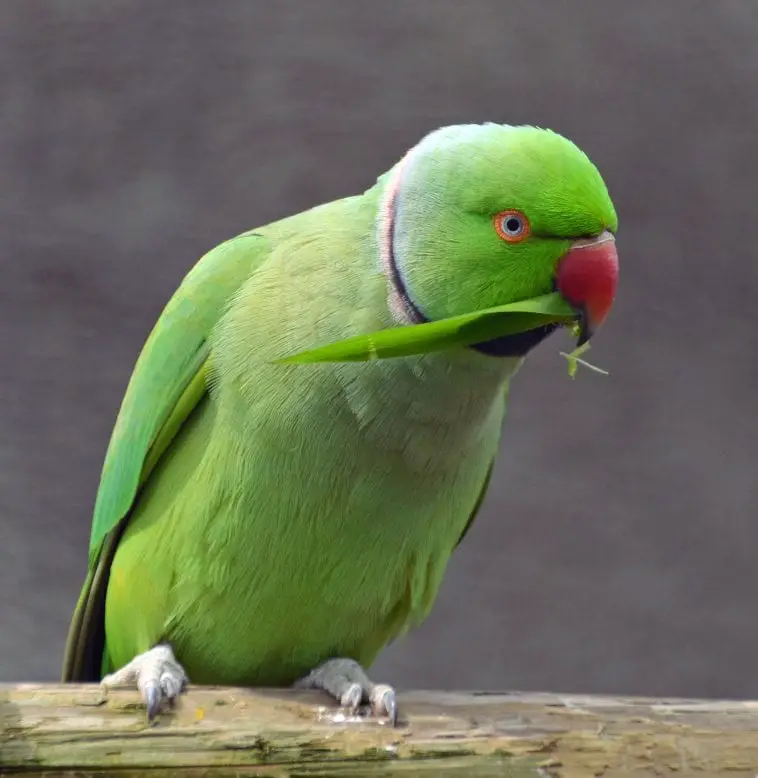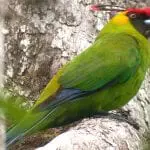Scientific Facts
| Common Name | Ringneck Parakeet |
| Scientific Name | Psittacula krameri |
| Lifespan | 15 – 30+ Years |
| Size | 15.6 inches (40cm) |
| Mass | 4.1 – 5.0oz. (116 – 140 grams) |
| Habitat | Grassland, savanna, forest, shrubland artificial and terrestrial wetlands |
| Native Range | South Asia and Africa |
Information & Physical Appearance
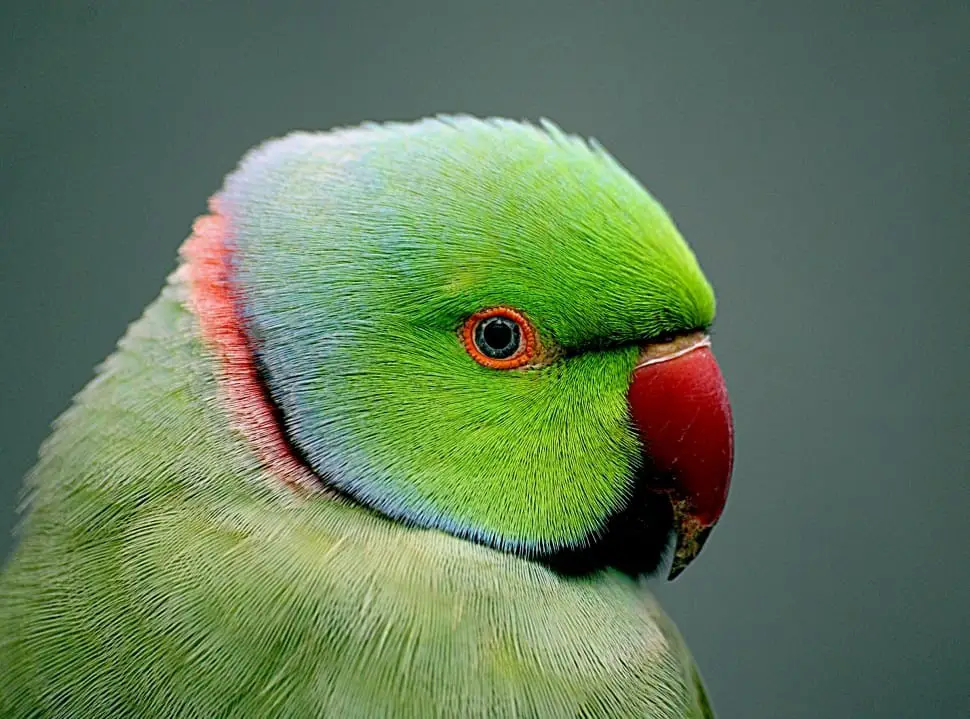
The Ringneck Parakeet (Psittacula krameri) is a medium-sized parrot classified in the order Psittaciformes, the family Psittacidae.
Other common names include Green Parakeet, Indian Parakeet, Indian Ringneck, Northern Rose-ringed Parakeet, Rose-ringed Parakeet, Senegal Long-tailed Parakeet, and Long-tailed Parakeet.
Including the nominate race, there is a total of four races.
1. P. k. krameri (African subspecies).
2. P.k. parvirostris (African subspecies).
3. P.k. borealis (Asian subspecies).
4. P.k. manillensis (Asian subspecies with multiple color mutations).
P.k. krameri – African Rose-ringed Parakeet
Adult male P.k. krameri species display generally green/yellow colors. There is a wide black-colored stripe that spans across the lower cheeks. The chin is black.
Also, there is a distinct pink “collar” located just below the nape (aka the hindneck), as if creating a ring, and hence the common name “ringneck.” Additionally, the back of the neck (the nape) features washed blue nuances.
The thighs are green, and the eyes are bright yellow. The lower mandible is dark red at the base, and the rest of it is fully black. The upper mandible is dark red and is further tipped with black.
Female African rose-ringed parakeets differ from males, as they lack the notable head markings. The collar is faint yellow/green. As compared with males, the tail is shorter.
Juveniles resemble mature females, but the bill is visibly paler. Also, the eyes are grey.
P.k. parvirostris – Abyssinian Rose-ringed Parakeet
Adult males share a fairly similar coloration to that of P.k.krameri species. However, the cheeks, as well as the head, are visibly greener and less yellow.
The bill of P.k.parvirostris differs from the bill of the African Rose-ringed parakeet, as the upper mandible is brighter red in color, and the bill is smaller in size.
P.k. borealis – Boreal Rose-ringed Parakeet
P.k.borealis species have a green plumage, while the yellow is lacking. On the sides of the head, just behind the ears, adult males display blue suffusion.
The bill is large and is entirely red in color. The Boreal Rose-ringed Parakeet is also larger in size, as compared with the other races.
Juveniles feature the same colors as adults.
P.k. manillensis – Indian Rose-ringed Parakeet
P.k.manillensis species are very similar to P.k.borealis species. However, the lower mandible is black in color.
Adult males have facial marks, and the pink ring around the neck is more noticeable.
The plumage of juveniles is the same as in adults.
Short Summary
Both Indian subspecies are larger in size than the Asian subspecies.
The rose-ringed parakeet is sexually dimorphic, and so while the adult male sports a visible black and red neck ring, females, as well as immature individuals of both sexes alike, are known to display only pale to dark grey, shadow-like neck rings or collars.
In both sexes, the plumage is distinctly green in the wild, yet with captive-bred varieties, there are numerous color mutations, including yellow, violet, and blue.
Measuring an average length of 16 inches (the tail feathers included, making up for a big portion of their total size in length), the average size of the wing is estimated at around 5.9 to 6.9 inches.
Lifespan
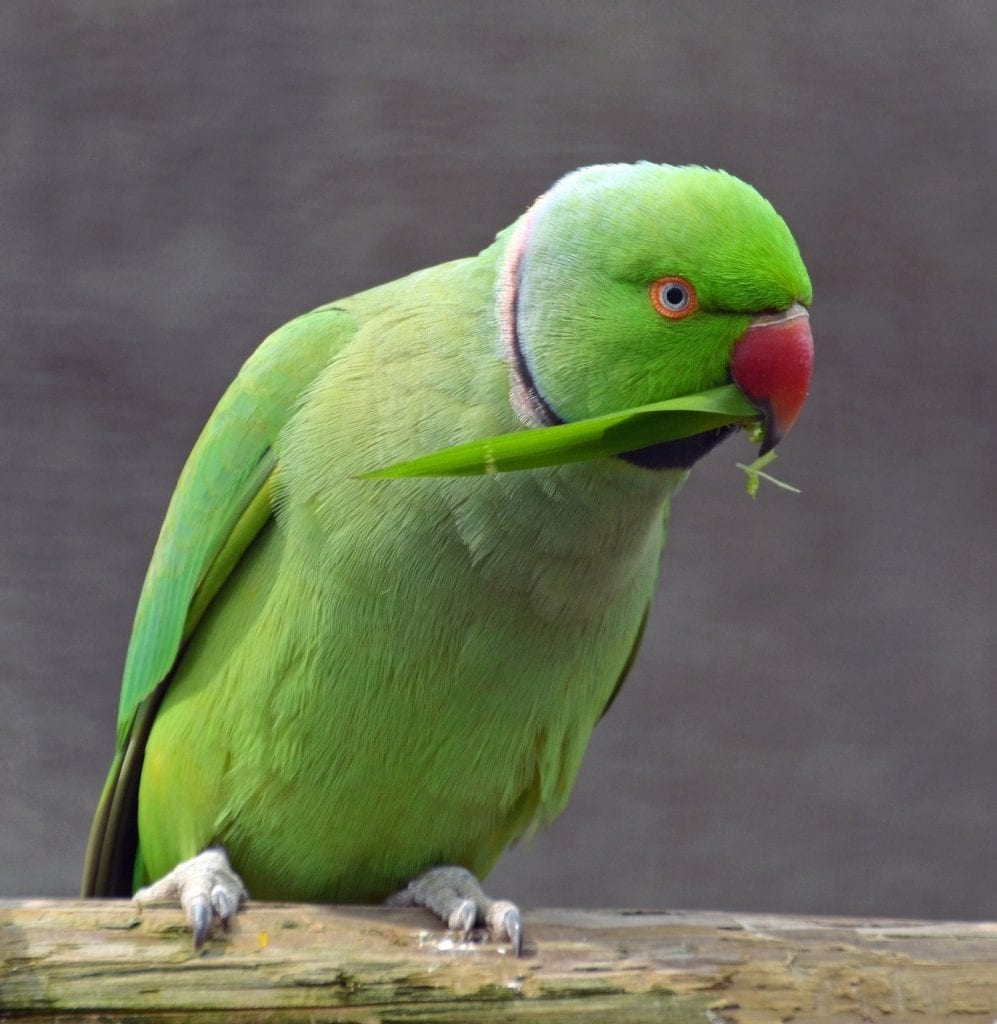
Ringneck parakeets, including both the African and the Indian subspecies, are known to live for up to 15 – 30 years in captivity on an average.
In the wild, these birds may manage to live up to 50 years of age, as there are existing reports of such long-lived individuals.
The key to a long life span when it comes to the captive specimens is none other but conscious care, love, and attention for keeping these feathery fellows healthy and happy, living up to their fullest potential.
The generation length is estimated at 7.6 years.
Ecosystem & Habitat

Range
P.k. krameri (African rose-ringed parakeet)
This species occurs in western Africa, namely in Senegal, Guinea, and southern Mauritania. Also, they occur in southern Sudan, western to east Uganda, as well as in the territories north to Egypt.
The African rose-ringed parakeet is a resident in Giza and along the Nile Valley. Sometimes, it can be seen in Sinai and on the north coast, as well.
It was in the 1980s when the African rose-ringed parakeet began breeding in Israel and is nowadays considered an invasive species.
P.k. parvirostri – Abyssinian rose-ringed parakeet
This species occurs in the west across Northern Ethiopia, reaching to Sudan, in particularly, Sennar district. It is also occasionally found in northwest Somalia.
P.k. borealis – Boreal rose-ringed parakeet
It inhabits Nepal and northern India, all the way to central Burma. It is also widely distributed in Pakistan and Bangladesh. When it comes to introduced populations of this species, such are found worldwide.
P.k. manillensis – Indian rose-ringed parakeet
This species has originated in the southern Indian subcontinent and is nowadays known to occur in mainland India, Sri Lanka, and Rameswaram Island. Naturalized, as well as feral populations, are found worldwide.
It is in the U.S., Great Britain, and Australia, among other western countries, where this species is most commonly referred to as Indian ringneck parrot.
Habitat
The ringneck parakeet’s habitat consists of a wide range of woodland types. This parakeet can be found in riparian woodland, secondary tropical forests, savannas, mangroves, and, nonetheless, open farmland characterized by scattered trees. It is not uncommon to see ringneck parakeets inhabiting gardens and parks in urban areas.
In Africa, this bird species occurs at up to 6560ft. elevation.
Food & Diet
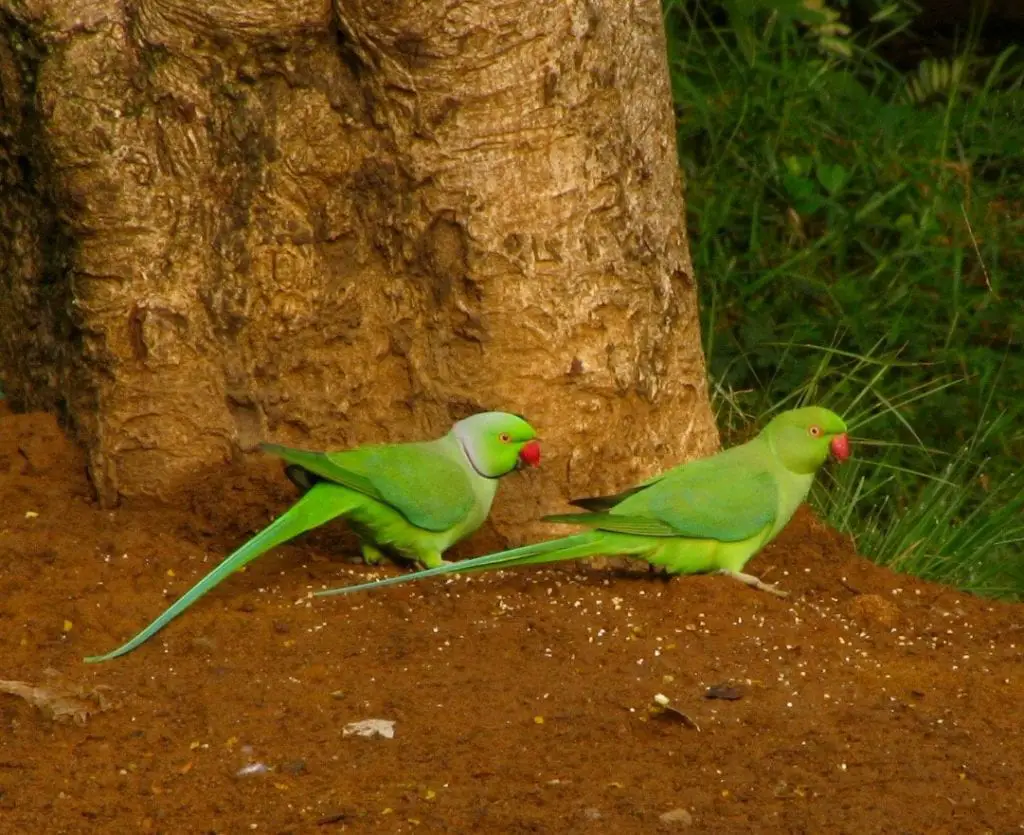
In the wild, the Ringneck Parakeet is known to eat a variety of plant-based foods, such as seeds obtained from different weeds and trees, cereal grasses, flowers, buds, nuts, berries, cultivated citrus fruits, vegetables, maize, sunflower, as well as flower nectar.
Wild flocks will fly for several miles in order to forage in orchards and farmlands where food is especially abundant, yet the species also causes extensive damage, and ultimately, a negative economic impact on humans on that note.
Cereal grains make the major part of the diet of ringneck parakeets in India. During the winter, they are known to consume pigeon peas.
During the spring in Egypt, ringneck parakeets will predominantly feed on mulberry, while during the summer, they will gladly consume dates. Also, the ringnecks thriving in Egypt are to nest inside palm trees, often eating from corn and sunflower fields nearby.
Behavior & Ecology
The Ringneck parakeet is an especially highly adaptable bird species.
These birds are known to roost communally. It is often the case that they will roost together with other parrots, and nonetheless, mynas and crows, among other species.
Outside the breeding season, the ringneck parakeet is exceptionally social.
Overall, this species of bird is not aggressive and is not territorial. Large flocks that consist of several thousand birds are formed at a time.
The unique call of the ringneck parakeet makes up for a curious part of its behavior and ecology. The call is very noisy and squeaky. These birds are rather vocal, and especially at communal roosts.
The call consists of a large assortment of shrieks, as well as whistles. Other sounds are also included.
Typically, the ringneck parrot calls by releasing a series delivered in bursts of between 3 and 6. These are followed by a short pause and can be soft and more musical, or harsh and shrill.
While in flight, ringnecks call, too.
Reproduction

In general, the breeding season begins in early January and continues up to late April. Sometimes, the breeding season may also proceed throughout July.
The clutch consists of 4 and up to 6 eggs. The eggs are oval, measuring 1.2 x 0.9 inches in size.
Ever since the 19th century, the ringneck parakeet has managed to colonize many other countries, apart from its native range, where it successfully breeds.
This species is known to breed further north, as compared with any other species of parrots.
Thanks to successfully breeding, the ringneck parakeet is especially well-established in southeast England, particularly in London, as well as in the southern states of the U.S., although somewhat less successfully established there.
This parakeet also breeds in the Netherlands.
Indian rose-ringed parakeets are known to form mating pairs from September to December.
Unlike lovebirds, ringneck parakeets do not mate for a lifetime. They will usually breed with a different partner during the next breeding season.
When faced with the cold weather during the breeding season, ringnecks will select, and then defend their nest sites. This is done for the purpose of avoiding competition sites with other breeding birds in the region.
By feeding on winter pea crops, females manage to obtain more essential nutrients in order to produce eggs.
It is from April to June that ringnecks care for their offspring. Just before the monsoon, fledglings are all ready to leave the nest, becoming fully independent from their parents.
Survival Threats & Conservation
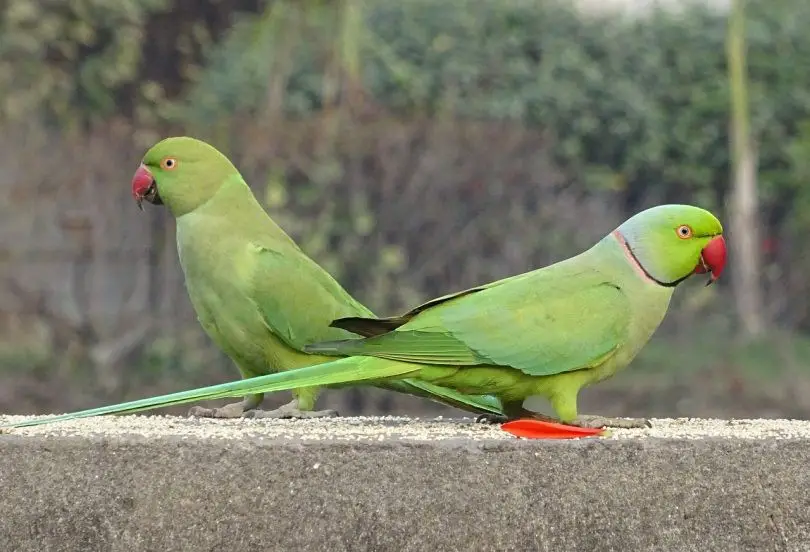
The Ringneck Parakeet is listed as Least Concern on the International Union for Conservation of Nature (IUCN) Red List of Threatened Species. That’s because the population appears to be increasing.
Additionally, the expansion of agricultural seems to be beneficial to this species in terms of increasing in number due to the higher availability of food.
However, because of the ringnecks’ unpopularity with farmers, as well as because of these birds being especially popular in the pet trade, some of the populations in some parts of its native range have been progressively decreasing. Also, there is no systematic monitoring scheme for this species, but conservation sites are identified over the entire range.
Human Interaction & Domestication
The Ringneck Parakeet is especially widespread in captivity. These birds are known to thrive on interaction with humans and have been successfully domesticated for years.
With disjunct native ranges in South Asia and Africa, ringnecks are now introduced into many different parts of the world. Feral populations are well-established and are widely bred for the exotic pet trade with big success.
In recent years, the impressive color mutations of the Indian rose-ringed parakeet subspecies have become especially sought after, and this, widely available as a result of the high demand.
One of the color morphs that are most commonly kept in aviculture includes the blue color morph mutation.
Birds with blue color morph mutation are known for their beautiful, solid, light blue feathers, instead of the traditional green. Also, they lack the rings that are typical for their counterparts.
Other striking colors among Indian ringnecks include white and yellow (lutino), to name a few.
Even though the normal, “ordinary” green coloration is itself wonderful and bright, the color-muted birds have progressively become more popular than their wild-colored relatives.
The popularity of Ringneck Parakeets as pets keeps growing because of several reasons which make up for the exceptional appeal of these birds.
First off, ringnecks have a solid reputation as exceptional talkers. They are capable of learning to speak many words with amazing clarity.
Secondly, ringnecks are strikingly beautiful, and only reach a medium size, which makes them even better suited as beloved household companions among a diverse population of bird lovers.
Ultimately, these birds possess an array of fascinating traits, including their sociability and curious, amusing behavior, fully deserving the respect they receive.
Availability – Where to Get a Ringneck Parakeet
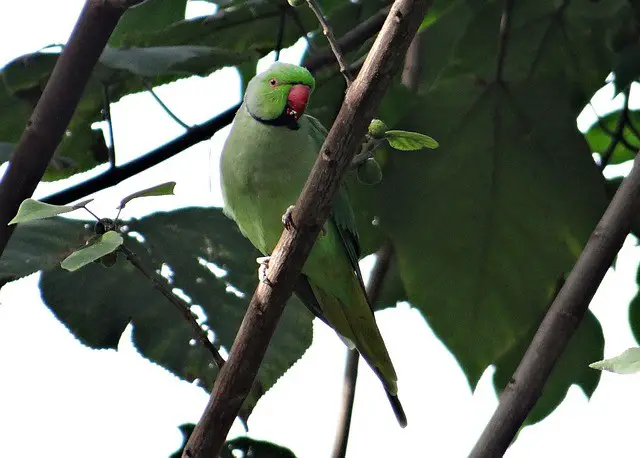
One can get a ringneck parakeet to keep as a pet from a wide variety of online and offline vendors, including breeders, pet stores, and various expos.
As with other species of birds that can be kept as pets, it is best to opt for captive-bred individuals. Additionally, one can acquire a ringneck parakeet that is already tame.
Not the least, there is a big number of ringneck parakeets that are in dire need of new homes. Therefore, it is possible to contact the nearest education and adoption foundation (alternatively, a parrot rescue), in order to help by adopting one of these amazing creatures, granting them the chance to live the happy, healthy life they fully deserve.
Interesting Facts
1. The Ringneck Parakeet is one of the very few species of parrots that have managed to successfully adapt to living in disturbed habitats. This amazing species has withstood the onslaught of both deforestation and modern-day urbanization.
Being especially popular as pet species, some of them escaped birds have colonized various cities all over the globe, including a number of cities in Western and Northern Europe.
Ultimately, the Ringneck Parakeet has proven itself fully capable of thriving in a variety of climates and conditions outside of its native range. In fact, this bird species are capable of surviving even the low winter temperatures in the northern parts of Europe.
2. The genus name of this species – Psittacula – is derived from the Latin word “psittacus,” which translates as “parrot.” The specific word “krameri” in the scientific name is a commemoration to Wilhelm Heinrich Kramer, a memorable naturalist from Austria.
3. The popularity of Rose-ringed parakeets in aviculture dates back to ancient times. For instance, the ancient Greeks are known to have kept one of the Indian subspecies as a pet (P. krameri manillensis). Meanwhile, the ancient Romans are known to have kept one of the African subspecies, namely P. krameri krameri.
4. For many years, ringneck parakeets used to be mainly regarded as an “ornamental” species of bird. However, over time, people have got to learn that when given care and attention, these birds can grow into especially affectionate, loving pets.
It is important that the caregiver is to start hand-feeding the bird ever since it is a baby in order to tame it. Apart from enjoying being held by their owners, ringnecks do also thrive in environments where they are properly trained, interacted with, and, ultimately, socialized.
5. Both male and female ringneck parakeets are capable of mimicking human speech.At first, the bird is to listen to its surroundings. Next, the bird is to copy the voice of human speaking. It is for this very purpose why some people hand-raise rose-ringed parakeet young chicks since such parrots are to become very receptive to learning, and quite tame in general.
6. During their adolescence, Ringneck Parakeets are known to undergo a “bluffing phase,” just like some other types of birds do.The buffing phase is a result of the hormonal changes that occur during this life stage. Unfortunately, many inexperienced owners tend to stop interacting with their bird pets properly during this phase, which results in the inevitable loss of some much-wanted behaviors.
In order to get through the bluffing phase, the caregiver must not give up, but instead, he/she needs to keep working with the bird as the feathery fellow goes throughout these peculiar hormonal stages.
The hallmarks of bluffing include hissing, nipping, lunging, and biting, among general resistance to interacting with humans.
A ringneck that is bluffing will put the caregiver’s patience to the test over and over again, yet the most important thing to remember is that this, too, shall pass. Ringnecks can enter the bluffing stage literally overnight, usually when between 4 and up to 12 months of age.
7. There is a feral population of ringnecks, even in Japan. It was back in the 1960s when many Japanese people acquired ringneck parakeets as pets for the first time. Thus, this bird was widely imported. Some of the imported birds managed to escape from their owners, and some were released by their owners. This causes populations to successfully form around the country.
Just 20 years later, in the 1980s, groups of ringnecks could be found in Kyushu, Nagoya, Niigata, Osaka, and Tokyo. Even though some of the groups died out, there was an especially large population occupying the main campus of the Tokyo Institute of Technology as of 2009.
How to Care for the Ringneck Parakeet
1. Housing
The Ringneck Parakeet is an active, social, medium-sized parrot that can thrive in captivity when provided with a walk-in type of aviary. The minimum length of the aviary must be 14.7ft.
Indeed, the caging requirements for this bird include a cage that is larger than what newbies might expect. However, a properly sized accommodation is key, since these birds have long tails, so the cage must allow them to hop around and play freely whenever the owner is not around.
Not the least, mind the bar spacing. It should not be too large or too small to get the bird stuck, and neither should it allow for the bird to possibly escape through.
2. Diet & Feeding
Feed small seed mixtures, including millet, buckwheat, small amounts of oats, canary seed mixtures, sunflower seeds, and safflower seeds.
Also, green leaves, seeding grasses, and spray millet should be provided.
The Ringneck Parakeet will gladly consume a wide variety of fruits, including bananas, apples, oranges, and mangoes. Mind that some fruits may not be accepted, and the animal must not be forced at any time to eat them.
Provide complete kibble, too.
As a rule of thumb, offering a nutritionally balanced pelleted diet is the best way to keep a captive ringneck healthy and happy, yet a variety of fruits and vegetables should be also added to a proper, varied diet.
Note that vegetables and leafy greens are crucial in the maintenance of a nutritionally sound diet. Healthy cooked food can be offered, too, such as chicken, grains, rice, and beans.
Do not offer avocado, nor chocolate, as both are toxic to birds.
It might be the case that some ringnecks will sort out, and then leave behind pellets when these are mixed with seeds.
Fortunately, this is basically the only thing that ringnecks seem to be picky about when it comes to their eating habits and preferences. In such a case, it is best to offer seeds and pellets separately.
Also, rotate pellets and seeds on a regular basis. Usually, ringnecks will come back around their food, even in cases when they don’t get to consume something right away.
Important Note
Water and food containers must be emptied, then cleaned and refilled on a daily basis. This is needed in order to reduce the chances of unwanted bacterial growth and infection.
3. Exercise
Considering that parakeets are very active birds, it is best to provide a safe area out of the cage, where they can play and stretch their wings daily for several hours.
Also, these birds have powerful jaw muscles that need to be maintained well. Because of this, it is a good idea to offer an array of chewable toys. Additionally, provide perches and other suitable cage accessories to help the bird gnaw on something that is neither dangerous nor valuable.
Ringneck parakeets are known to enjoy just about any type of complex toys. These will greatly help in keeping these curious companions busy and entertained.
To ensure that the ringneck parakeet pet will be as happy and as healthy as possible, provide a mister, as well as a water dish for bathing purposes.
4. Temperament & Handling
Ringneck parakeets can quickly become one of the most beloved companions and family members, as long as they are provided with adequate care, handling, love, and attention, ever since an early age.
These birds really enjoy learning new things. Provided the owners are willing to invest enough time to challenge this species’ intelligence, the birds can be especially proficient with their caregivers. They are capable of developing very large vocabularies, and nonetheless, learning a lot of bird tricks.
In the case, the owner is to notice any form of aggressive behavior, the best thing to do it so avoid scolding. Or else, the bird may develop a fear of people for a lifetime.
Instead, bad behavior should be ignored, and positive reinforcement should be used, as it is good behavior, which makes the best way to handle a ringneck properly.
The reputation for being hard to train and nippy is generally undeserved. Ringnecks are exceptionally smart, so they simply tend to get bored rather easily, which often resorts to different forms of destructive behavior, such as chewing, when the bird is left to its own devices.
For some owners, it tends to be especially challenging to handle a ringneck parakeet when the bird is going through a bluffing stage.The bluffing phase is characterized by slight aggression. However, this phase only lasts for about a few weeks or a maximum of a few months.
The personality of each captive ringneck parakeet is greatly determined by the owners’ care, love, and attention. If handled often, and properly taken care of, ringnecks can develop extremely sweet, adorable, charming personalities.
The ringneck’s voice is almost comical. It is rather high-pitched, yet simultaneously, it is a sweet little voice to enjoy.
In fact, ringneck parakeets are great at alerting their owners to just about any danger. This is actually an all-natural instinct since, in the wild, ringnecks use very loud calls to signalize about possible danger.
In general, ringnecks are not very affectionate. However, females do tend to establish a stronger bond with their caregivers than males, yet males happen to be more easy-going.
All in all, ringneck parakeets are considered low-maintenance birds to keep as pets, but this does not mean that they don’t require plenty of time and attention in order to live up to their fullest potential.
5. Cleaning & Maintenance
Food and water containers should be cleaned and refilled every day.
Perches and toys should be cleaned at least once every week.
The floor of the cage should be cleaned at least once every month.
Everything in the cage (including the cage itself) should be taken outside and hosed down at least once a year.
6. Cage Enrichment
Apart from bird-safe, suitable chewable toys, it is a good idea to provide bird-safe, chewable wood, and/or pine cones that have been heating sterilized.
Other appropriate accessories include climbing ropes, foot toys, leather toys (vegetable tanned), push-and-pull toys, and swings.
7. Breeding
Select a pair of healthy birds to breed.
Isolate the breeding pair from other birds, keeping the pair together in a separate aviary, as to let them get to know each other better.
Don’t forget to monitor the pair closely, as females that are not interested in mating with the male partner can cause him harm.
Several weeks before breeding, start feeding the pair with a calcium- and vitamins-rich diet.
Breeding ringneck parakeets require a suitable nest box. The nest box should be a vertical box measuring 12″ x 12″ x 18″.
Fill the nesting box with suitable bedding materials, e.g., wood shavings.
It is best to put a nesting box in the aviary in early spring. Even though the breeding period starts in the wintertime, cold weather can cause issues with the eggs.
Note that the incubation period lasts for 23 – 34 days, and the fledging age is 7 weeks. Allow the parents to incubate their eggs.
Upon hatching, the young chicks weigh about 0.2oz., and the peak weight is 4.5oz.
After hatching, monitor whether the parents are taking proper care of their young. Although rarely, the parents may choose to abandon their chicks, and so the owner will have to step in by hand-rearing the young.
8. Common Health Issues
Ringneck parakeets are generally hardy creatures. However, just like with humans, various health issues may arise.
The most common health issues to occur with ringnecks include Psittacosis or Parrot Fever, Pacheco’s Disease, Aspergillosis, Psittacine Beak, and Feather Disease (PBFD).
By providing a healthy, balanced, varied diet, proper housing, dedicated care, and regular check-ups with a qualified vet, any of these health issues can be prevented from ever happening.
Healthy ringneck parakeets will be active, with smooth feathers, and they will not wheeze or make clicking noises on the inhale. They will have good balance, bright eyes, no sores or flakes on the feet, and no swelling on the beak.
FAQs
Where Are Ringneck Parakeets from?
Ringneck Parakeets come from southern Asia and Africa. This is where they are originally from, but nowadays, they have managed to establish populations in many other countries outside of their native range.
Are Indian Ringnecks Good Pets for Beginners?
Indian Ringnecks are considered low-maintenance birds to keep as pets, and they can make good pets for beginners in general. These birds are great at learning tricks, they are very playful, social, and highly intelligent, capable of mastering vocabularies of up to 250 words, yet it is solely up to the caregiver to help them live to their fullest potential.
Are Male or Female Indian Ringneck Parakeets Better?
Female Indian ringneck parakeets are known to possibly establish stronger bonds with their caregivers. However, male Indian ringneck parakeets are more easy-going in general, so whether a male or a female ringneck parakeet makes a better option is a strictly personal matter of choice.
Are Ringneck Parakeets Cuddly?
It is fair to state that Ringneck Parakeets are relatively cuddly pets, even though they used to be mostly regarded as “ornamental” back in time. It is only the ringneck parakeets that have been handfed ever since babies, and raised properly, to turn into loving and affectionate companions that enjoy interacting with humans, including a bit of cuddling.
Do Indian Ringnecks Get along with Cockatiels?
Indian ringnecks do not really get along with cockatiels since they do not do well with competition in general. Instead, they prefer to be the only pet, so if owners wish to keep Indian ringnecks along with cockatails, ringnecks should be provided with plenty of private room and plenty of love to avoid possible mishaps.
Are Ringneck Parakeets Affectionate?
Ringneck parakeets can be affectionate with humans, as long as the owner starts working with the bird at a very young age. Furthermore, ringnecks require daily work and attention in order to become friendly and trusting with their caregivers, but once they do so, they are fully capable of showing affection.
Do Ringneck Parakeets Bite?
Yes, ringneck parakeets may sometimes attempt to bite, yet this is mostly the case with ringnecks going through their buffling phase, or ringnecks that have not been taken proper care of. If a ringneck parakeet attempts to bite you, you should not spray the bird, flick the beak, or wobble your hand, as the bird does not understand this type of punishment, and can become fearful and aggressive to humans for a lifetime in return.
Do Ringneck Parakeets Go through Puberty?
Yes, ringneck parakeets do go through some form of puberty as they reach adolescence, and this particular stage of their development is known as a buffling phase. The buffling phase can occur once the ringneck turns 4 and up to 1 year of age and is characterized by changing moods because of the occurring hormonal changes, often resulting in the birds becoming nippy and grouchy until the phase ends within a few weeks or months.
How Long Do Ringneck Parakeets Live?
Caged ringneck parakeets are found to usually live between 15 – 25 years. In the wild, ringnecks typically live for 20 – 30 years, and there are documented cases of some of these birds living up to 50 years of age.
At What Age Do Ringneck Parakeets Start Talking?
Ringneck parakeets will start to talk at about 7- 12 months of age, yet this period greatly depends on the bird itself, since some ringnecks may reach over 1 ½ years of age before saying a single word, while other ringnecks may refuse to talk at all. Just like with humans, every ringneck parakeet is unique and learns at his/her very own pace, keeping in mind that the role the owner plays as a teacher to help the bird start talking is key.
At What Age to Ringneck Parakeets Get their Ring?
It is male ringneck parakeets top develop a noticeable ring around their necks, which usually becomes more apparent when they turn about 17 months of age.
Can Ringneck Parakeets Eat Bananas?
Yes, Ringneck parakeets can do well on eating bananas as part of a varied diet, although occasionally, some individuals may refuse to accept certain fruits, and this is totally fine. Ringneck parakeets can be offered a variety of washed fresh fruits, e.g., grapes, pomegranates, watermelon, apricots, cherries, apples, peaches, cranberries, as well as dried fruits, e.g., papayas, mangoes, pineapples, among others.
Can Ringnecks Eat Oranges?
Yes, ringnecks are known to enjoy eating sweet and juicy fruits like oranges. It is best to offer suitably-sized sections of non-sour citrus fruits, including tangerines, as treats.
What Food should Ringneck Parakeets Not Eat?
Some types of food are harmful to ringneck parakeets, and some may even be poisonous. Ringneck parakeets should not be allowed to eat raw onions, raw cabbage, avocado, persimmons, eggplant, apple seeds, and green parts of tomatoes, or green parts of potatoes, rhubarb leaves, and mushrooms, among others.
How Much Does an Indian Ringneck Cost?
Indian Ringnecks cost about $400 – $500 on average, but do not that some of the more exotic color mutations cost more. It is best to purchase hand-raised Indian ringnecks, with tame individuals typically costing about $700.
Is the Ringneck Parakeet Endangered?
The Ringneck Parakeet has been found to be one of the most highly adaptable species of birds. Even though some of the populations of ringneck parakeets in the wild have declined, there appear to be no serious threats to the future survival of this species, and it is only listed as Least Concern by the IUCN.

